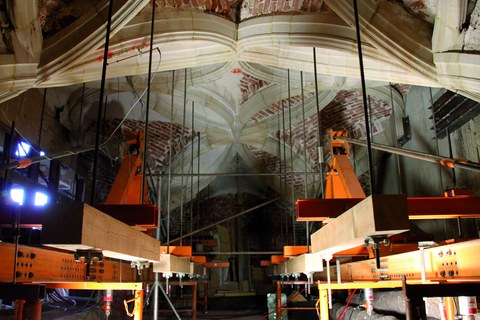Probebelastung des Mauerwerksgewölbes der Schütz-Kapelle im Dresdner Schloss
Inhaltsverzeichnis
Projektdaten
|
Titel | Title |
Bericht aus dem Jahrbuch 2013
Probebelastung der Schützkapelle

Belastungsrahmen und Zugstangen unter dem Probejoch
Die Rekonstruktion der Schützkapelle ist eines der letzten großen Bauvorhaben im Dresdner Schloss. Hier wurde u. a. innerhalb von drei Jahren ein Schlingrippengewölbe nach historischem Vorbild errichtet.
Um fertigungstechnische, handwerkliche und qualitative Aussagen treffen zu können, wurde zuerst ein Gewölbeabschnitt als Probestück im Maßstab 1:1 errichtet. An diesem Probejoch sollte das Tragverhalten eines solchen Gewölbes experimentell bestimmt werden, um die statische Berechnung abzusichern. Vor allem sollten die experimentell ermittelten Verformungen mit den rechnerisch bestimmten verglichen und die Standsicherheit nachgewiesen werden. Mit der Durchführung dieser Belastungsversuche wurde das Otto-Mohr-Laboratorium der TU Dresden beauftragt.
Grundlage für den Belastungsversuch war die DAfStb-Richtlinie „Belastungsversuche an Betonbauwerken“, die auch für andere Bauwerke des Massivbaus sinngemäß angewendet werden darf.
In der Berechnung des Gewölbes wurden Flächenlasten angesetzt. Eine solche Belastung konnte vor allem aufgrund der durch die Wölbungen und Rippen sehr ungleichmäßigen Oberfläche nicht realisiert werden. Die Alternative war das Eintragen von insgesamt 48 Einzellasten in ausreichend kleinen Abständen. Diese wurden über Gewi-Rundstähle Ø 18 in das unter dem Gewölbe aufgebaute Zwischengeschoss geleitet. Dort wurden jeweils vier Einzellasten über ein Trägersystem zusammengefasst. Jede der zusammengefassten zwölf Einzellasten war durch einen separaten Hydraulikzylinder steuerbar, der mit einer elektrischen Kraftmessdose gekoppelt war. Die Widerlager der Hydraulikzylinder bildeten zwei stählerne Belastungsrahmen, die an zwei Stahlbetonunterzügen verankert waren.
Es wurden fünf verschiedene Laststellungen realisiert. Dabei wurden vertikale und horizontale Verschiebungen und an ausgewählten Stellen die Dehnungen an der Ober- und Unterseite des Gewölbes mit induktiven Wegaufnehmern aufgenommen, die an einer separaten Messbasis befestigt waren.
Mit den Belastungsversuchen konnte die Tragfähigkeit des gesamten Probejoches in ausreichender Weise nachgewiesen werden. Die Verformungen im Versuch lagen teilweise wesentlich unter denen aus der Berechnung. Die Berechnungen und deren Grundlagen bilden das Tragwerk auf der sicheren Seite liegend ab und liefern damit den Nachweis einer auch nach heutigen Vorschriften sicheren Konstruktion.
